
Instagram: Wandering Landscape Architect
There is a “Wandering Landscape Architect” currently making a splash in the Instagram scene. If there is a slight anonymity about the page, it is done so intentionally. The creator behind the page is landscape architecture graduate, Emily Sutherland. Having traveled thus far to 18 countries, Emily decided to create a profile on the visually stimulating social media platform three years ago. She recalls, “I’ve always visited many places, and I had so many pictures but never knew what to do with them. So I decided to create this page as a way of storing them for my own reference and to have record of where I’ve been.”
Since then, the Wandering Landscape Architect page has been gaining momentum. In a world of filters, there is a strong sense of authenticity and reality in her pictures. In this interview feature, this wandering graduate talks about the inspiration behind her travels, taking the leap of journeying and feeding it all back into her work.
The Inspiration
“Natural landscapes is the driving factor,” Emily admits. Being originally from the Lake District, England’s largest and mountainous National Park, this is not surprising.
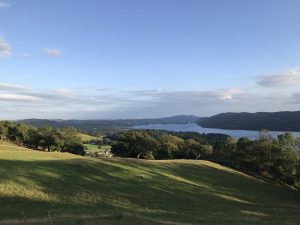
View over Lake Windermere from Troutbeck, 2017 © Wandering Landscape Architect

Lake Windermere from Loughrigg © Wandering Landscape Architect
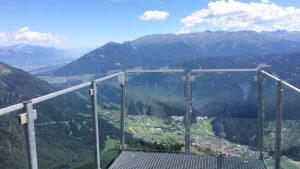
Stubaiblick Viewing Platform, Neustift, Austria, 2017 © Wandering Landscape Architect
She has just come back from her solo trip to Asia, visiting seven countries in total.
ES: “When I was between Universities, I went on a trip to Thailand and I always knew I wanted to go back.”
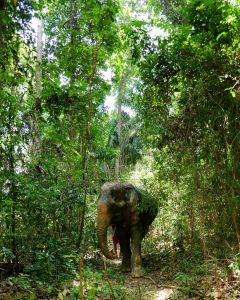
Krabi Elephant Sanctuary, 2018 © Wandering Landscape Architect
From idyllic pocket parks of Japan to tea plantations of Malaysia, her childhood journeys have expanded into bigger and further ventures to search for inspiration.

BOH Tea Plantation, Cameron Highlands, Malaysia, 2018 © Wandering Landscape Architect
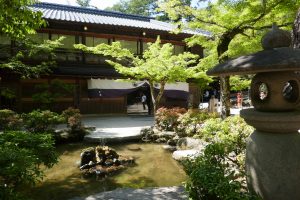
Miyajima Park, Japan, 2018 © Wandering Landscape Architect
ES: “I felt like I got to know Bali and Vietnam best just because I stayed there much longer (seven weeks each), which I think is a big part of liking somewhere. With Vietnam, I started from the south and slowly worked my way up to the north.”
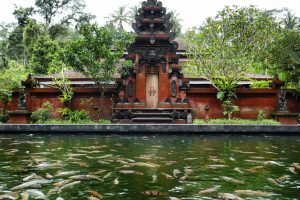
Water Temple, Bali, 2018 © Wandering Landscape Architect
Indeed, her journeys have a twist and her profile describes her “wandering the globe in search of inspiration.” Part of this process is to soak in the atmosphere.
ES: “Gardens by the Bay, for instance, I went to everyday for about three days in a row and probably spent more time there than the average person would. I can happily sit and watch the world go by.”
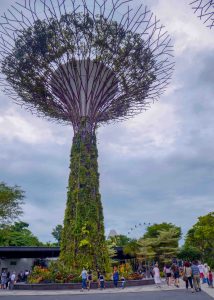
Super Trees at Gardens by the Bay, Grant Associates © Wandering Landscape Architect
As organised as her page may look, Emily takes a loose approach in translating the visual content. She is quick to point out, “I don’t think it’s a travel account and I try not to edit my photos too much. I don’t photoshop them. I might up the saturation and exposure, but I never change the image.”

Cloud Dome at Gardens by the Bay, 2018, Grant Associates © Wandering Landscape Architect
She adds, “I try to do it as soon as possible so that it’s still relevant but I don’t force a too strict schedule on myself.” As a result, her images seem tangible and within reach. It is this philosophy that makes the Wandering Landscape Architect page one of the most realistic and authentic pages on this social media platform.
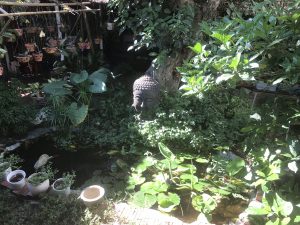
Restaurant Garden, Hoi An, Vietnam, 2018 © Wandering Landscape Architect
ES: “As it has grown, I’ve liked the social side of it. From other landscape architects and travelers, you find out things. It is actually a social world.”
This inspiration is displayed for different groups of people from not just Landscape Architects but also travelers and Emily’s nearest and dearest. Most of us can relate when she remarks, “None of my friends know what we do!” Certainly, as her page has grown, it has become an accessible tool for the public to see the projects designed by landscape architects.
ES: “I have some friends that follow it and said they had never realised that this is the kind of work I do.”
There’s not enough done to get our profession understood in terms of what we do and using social media hopefully will become more common. Some companies have picked up on its importance but I would push it a lot more. – Emily Sutherland
The Journeys
When speaking about doing the journeys as a solo female, Emily openly shares her experience in creating a community through staying in Hostels, making new friends and looking out for one another.
ES: “It was a bit daunting at times, I’m not going to lie! But I am a pretty sensible person. I was always with a group of people and rarely on my own.”
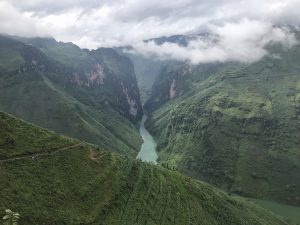
Ha Giang Pass, Northern Vietnam/China Border, 2018 © Wandering Landscape Architect

Ha Giang Pass, Northern Vietnam, 2018 © Wandering Landscape Architect
Travelling as a solo landscape architect is a different story and Emily points out another relatable point.
ES: “When I would go visit a landscape, I would like to spend a longer time there and enjoy it longer than most people would.”
Creating communities of her own along the way hasn’t led Emily to remain closed off and her trips have also been about connecting with communities.
ES: “When I first arrived in Bali, I did some conservation work, and I worked in a sea turtle conservation organised by local people and volunteers and got a chance to speak to them, see their point of view, and how they used the land. That was probably when I got to know the locals the best.”
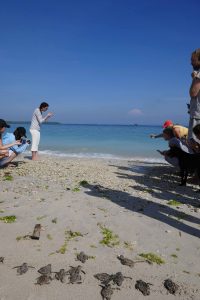
Turtle Sanctuary, Release Day, Nusa Penida, Bali, 2018 © Wandering Landscape Architect
The experience has also raised her environmental awareness as she recalls, “We also did a lot of beach cleanup. We would clean the beach everyday and find the same amount of plastic each day. It was quite eye opening.”
Her wandering journeys are kept as flexible as her Instagram posts.
ES: “I would normally go to a recommended place while keeping a flexible schedule and once there, I would research projects nearby. For example, I would ask people if there are any nice gardens. Quite often, I would stumble across special places, especially in Asia where there isn’t much publicity.”
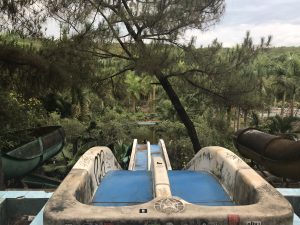
Abandoned Waterpark Hue, Vietnam, 2018 © Wandering Landscape Architect
ES: “I am glad I didn’t book much because most of the travelers I met didn’t book much either and we went with the flow. That meant I could stay somewhere longer if I liked it. If I didn’t, I could leave and I would try to get cheaper plane and bus fare and let that dictate a lot of my trips while keeping the cost down.”
She confesses that she wasn’t always like this and that travelling taught her to go with the flow. Her wandering trips also led Emily to certain key projects along the way such as visiting Singapore to see Gardens by the Bay or going to Japan to see some Japanese gardens.
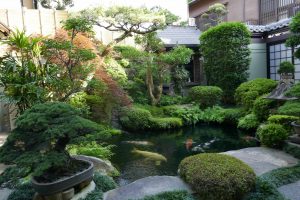
Souvenir Shop Garden, Miyajima, Japan, 2018 © Wandering Landscape Architect
The Work
Indeed, our widespread professional field allows us to find inspiration in almost every place we travel and ultimately for Emily, her ventures have paused for now to enable her to do some saving and gain further work experience. She’s no stranger to the workplace, having worked across the different stages of work from planning to construction, she has a realistic view.
ES: “There’s so much to learn and you realise how much you didn’t know until you start working. In this day and age, people don’t just have one job, they can be in multiple roles. Our profession may be a bit slow on the take of that because we have quite a lot of traditionally-minded people, and at times it might not be geared up for part time work or flexible schedules. It’s interesting. But it is inconsistent work and we need money, so you have to be consistent! Certainly it is still something I am figuring out.”
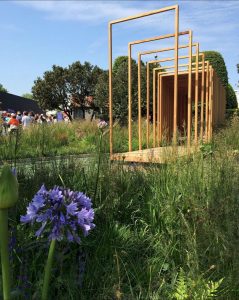
Chelsea Flower Show, Cloudy Bay Garden by Sam Ovens © Wandering Landscape Architect
She enthusiastically talks about her student research to design for homeless people as her Masters thesis.
ES: “I did my thesis on homeless people in the landscape and I had the opportunity to interview a lot of vulnerable people. It was called ‘Homeless People and the City.’ You see a lot about defensible architecture these days and we explored ways to help homeless people, including speaking to them about how they used the space, why they pick the areas where they sleep, what they need immediately, what are they lacking, types of lighting that’s best for them, etc.”
Her dream project?
ES: “Community led, high level master-planning of a deprived community with unlimited funds because we are in an imaginary world of course! That’s the dream.”
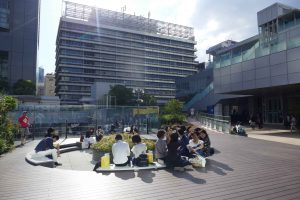
Suica’s Penguin Park, Tokyo, Japan, 2018 © Wandering Landscape Architect
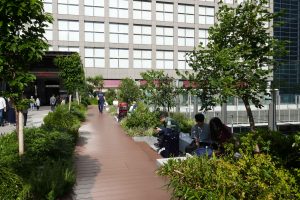
Suica’s Penguin Park, Tokyo, Japan, 2018 © Wandering Landscape Architect
Eventually, it becomes clear that her ultimate goal is far more complex than she had anticipated, which is essentially to integrate into one job, a space for: pushing for public engagement and awareness within the profession, running a practice which creates designs for communities that need it rather than want it, and continuing practical knowledge and inspiration! Certainly, this is a loaded mission and the conversation turns to millennial generation’s approach to job seeking.
ES: “Our generation asks what can this company do for us rather than the company saying what we can do for them. We kind of switch it around. We are probably fussy about where we work! In London, people seem to move around a lot more between practices. There is less loyalty to a company almost. You don’t hear of people staying somewhere for 30/40 years, I don’t know why that is but I do find it interesting. The fact that I was at my last practice for two and a half years, they thought was quite a small amount of time.”
Emily encompasses a fine balance of the inspired, relatable, and practical adventurer and no doubt we can find ourselves in the snippets of her experience and thoughts. Undoubtedly, the journey hasn’t ended for her. The current step is to find a job, which will enable her to save and travel to more places. She is keen to take more short trips in between working life and, in her true wandering style, is keeping these plans flexible.
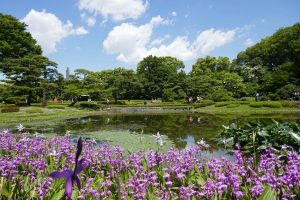
Kokyo Higashi Gyoen Gardens, Tokyo, Japan, 2018 © Wandering Landscape Architect
The Wandering Landscape Architect page is not only a source of public outreach, but also a reminder that there are wonders to be found in incidental and planned journeys. It is also a celebration of the work of landscape architects whose profession can most times be so subtle that its importance is overlooked.
If you want to know where the Wandering Landscape Architect journeys to next and to add a pinch of inspiration to your day, follow her on Instagram at Wandering Landscape Architect.
Published in Blog



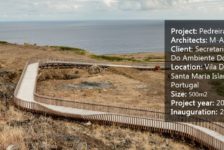


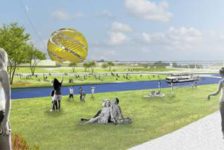
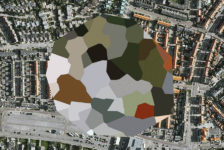


Pingback: Fields afar « Harmony Gardens